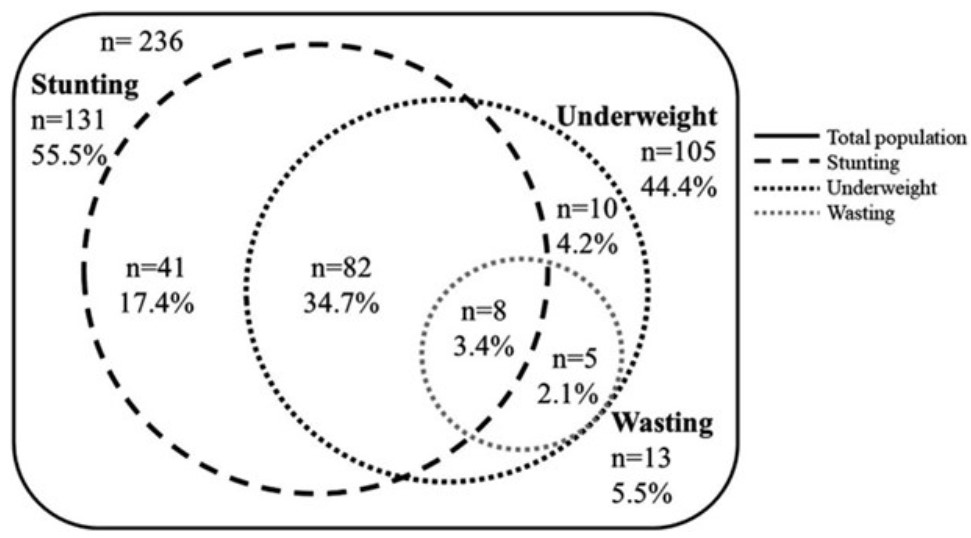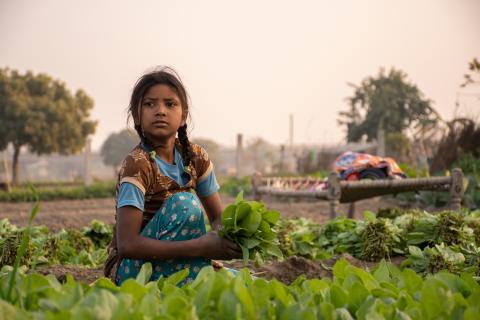Infant infection and nutrient deficiency predict impaired growth at five years: Pakistan
This is a summary of the following paper: González-Fernández D, Cousens S, Rizvi A et al. (2023) Infections and nutrient deficiencies during infancy predict impaired growth at 5 years: Findings from the MAL-ED study in Pakistan. Frontiers in Nutrition, 10, 1104654. https://www.ncbi.nlm.nih.gov/pmc/articles/PMC9982131/
This paper is a secondary data analysis of the MAL-ED1 cohort. A subgroup of 277 healthy newborns from Sindh province, Pakistan, was selected between January 2010 and February 2012 for study. The group was followed up to age 66 months, with 14% of the group lost to follow-up.
The 237 children were from low-income families. Overcrowding (>3 people per room) was present in 75% of homes, 15% did not have access to sanitation, and 81.5% of the study group lived with food insecurity. Stunting, underweight, and wasting prevalence were high (Figure 1).
Various regression models were used to predict the impact of assorted variables (at enrolment and during the study period) on future growth failure (at the end of the study period, e.g., 54– 66 months), using anthropometry, health records, questionnaire data, and biomarkers (faecal and blood).
Figure 1: Prevalence and overlap of stunting, underweight, and wasting in children aged 54–66 months

Stunting
Multivariate Poisson regression highlighted that acute lower respiratory infection, during the first year, at an average duration of ≥2 days per month was associated with increased stunting aged five years.
Underweight
Higher weight in the first days of life, receiving formula in the first six months, and commercial baby food feeding between 6-11 months were associated with decreased risk of underweight aged five years. Higher serum transferrin receptor concentration (indicative of intracellular iron deficiency) – but, importantly, below pathological levels – was associated with decreased underweight aged five years. No other iron status indicators were associated with child growth at five years. High neopterin levels (indicative of an immune response) in the first year and Campylobacter infection in the first six months were both associated with increased underweight aged five years.
Underweight + stunting
Lower weight in the first days of life, lower quantile family income, greater duration (days per month) of acute lower respiratory infection, and elevated neopterin (>6.8nmol/L) in the first year were each associated with concurrent underweight + stunting aged five years.
This study employed a robust methodology with detailed data cleaning and statistical controls. The sample size, although small for some variables (e.g., length and height data aged 0–35 months), was sufficient to answer the study objective. Various observations of variables with weaker correlations were found, but are beyond the scope of this summary.
Infant enteropathy and respiratory infection appear to predict future malnutrition and the targeting of Campylobacter and broader vaccination coverage may reduce child malnutrition in this population. The relationship between serum transferrin receptor concentration (anaemia), neopterin (inflammation), and malnutrition is complex, but these findings may also indicate that early malnutrition is the pathway for these associations aged five years. Efforts should focus on reinforcing exclusive breastfeeding under six months and supporting nutritious, diverse diets for children over six months, in addition to infectious disease prevention.


